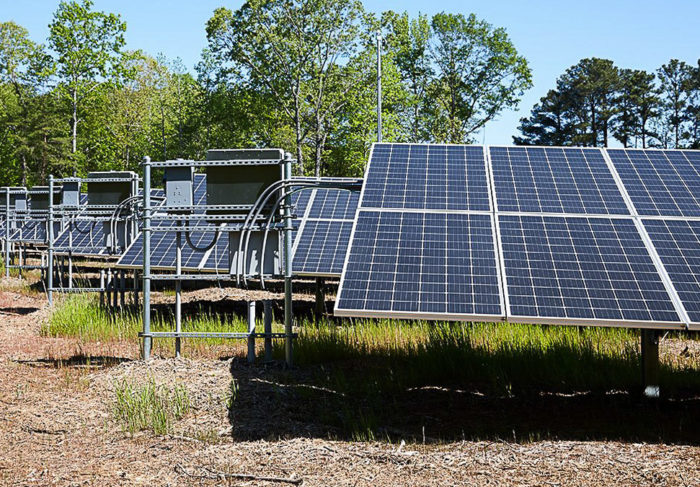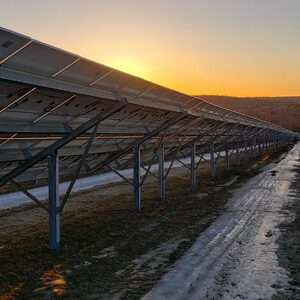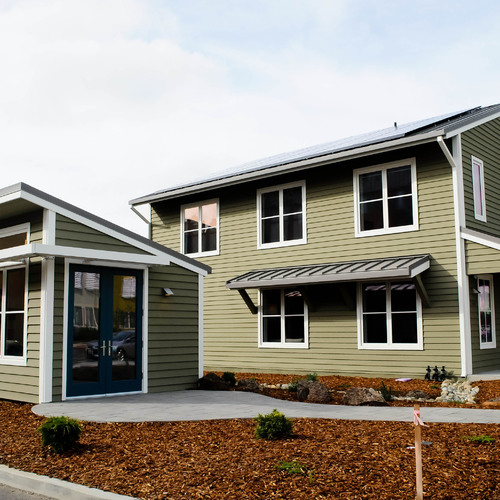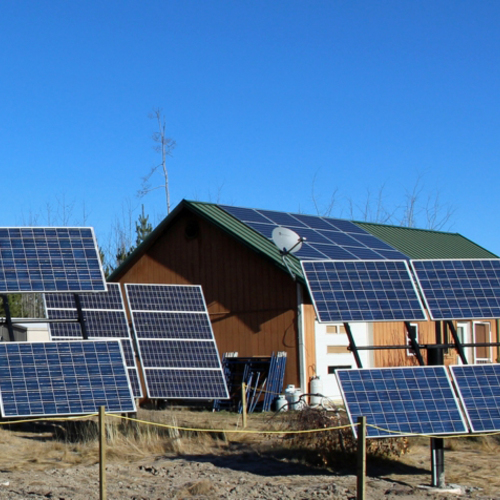
Reynolds Landing, a 62-house subdivision in a suburb of Birmingham, Alabama, features highly automated, energy-efficient homes — a boon for home buyers but also an unusual chance for Alabama Power and its corporate parent to peek into the region’s energy future.
The “smart neighborhood” is the largest in the Southeast to be connected to its own microgrid, a mix of solar panels, battery storage, and a gas-powered generator. Although part of the Alabama Power grid, the system is capable of supplying the subdivision with all the power it needs should the grid fail or go offline for maintenance.
There’s more to it than energy independence. The houses are equipped with the latest internet-of-things (IoT) technology that will give homeowners unusual control over how their houses operate, and allow Alabama Power to control electricity going to water heaters and heating and cooling equipment.
The utility sponsors of the project see long-term benefits to understanding how homeowners will use electricity in the years ahead as prices for renewable energy fall, codes tighten, and high-performance houses get a bigger slice of the housing market.
“This project is a 62-home living laboratory that helps us gauge how we’re going to serve our customers 20 years down the road as codes evolve and building construction techniques evolve,” Alabama Power’s Shon Richey said in a telephone call.
“A lot of times we get to do research on one, two, or three homes in kind of a vacuum in a lab scenario,” he said. “But being able to look at this on a grander scale with 62 homes with a very unique demographic that has not been jaded by anything we’re doing on a research perspective really gives us some great data about what the future looks like.”
Georgia Power, another subsidiary of the Southern Company, is building a community of townhouses, also on its own microgrid, in an Atlanta suburb. Unlike Reynolds Landing, each one of the 42 units will have its own solar panels and battery.
Houses built to exceed code minimums
Reynolds Landing is in Hoover, a city of about 85,000 a dozen miles or so from Birmingham. The houses were built by Signature Homes to specifications provided by Alabama Power. Features of these mostly electric houses include:
- Exterior walls framed with 2x6s on 16-inch centers and insulated to R-24 with blown-in fiberglass.
- Roofs insulated to R-49 with blown-in fiberglass.
- Zip sheathing and gasketed drywall to meet an airtightness target of 3 air changes per hour at 50 pascals of pressure (ach50), well below the state’s code requirement of 5 ach50.
- An average HERS Index score of 45, compared with an Alabama average for a code-compliant house of 70, according to Richey.
- Web-enabled Rheem hybrid heat-pump water heaters and Carrier Infinity heat pumps.
Richey said Alabama Power considered building the houses to the Energy Star standard but ultimately decided against it because some program requirements didn’t seem applicable for a project focused solely on energy use. The Zero Energy Ready program of the U.S. Department of Energy wasn’t a good fit, either. Regardless, Richey said, the houses should perform much more efficiently than those built to the current statewide energy code.
Alabama Power set no architectural requirements for the houses, so Signature Homes was free to build whatever it thought would sell. Richey said prices were about the “market rate” for the area — an average of $140 a square foot.
Connecting the houses with the microgrid
What really sets the houses apart is not so much the attractive energy numbers but the way in which the houses are connected to each other, the community’s microgrid, and the Alabama Power Col grid as a whole.
The microgrid consists of a 330 kW solar array, a 300 kW lithium-ion battery pack and a 350 kW gas generator, according to Ben Ollis of the Oak Ridge National Laboratory, a key partner in developing the system.
The equipment is located about 3/4 of a mile from the subdivision, feeding power to the houses underground. Excess power generated by the solar panels can be pushed to the Alabama Power grid beyond the community.
When the microgrid is disconnected from Alabama Power — what Oak Ridge researchers call “islanding” — power comes principally from solar panels and the batteries. In an extended stretch of bad weather, the microgrid would be able to run indefinitely with the generator alone.

“One of the primary purposes of installing a microgrid is enhanced reliability, especially for customers in far-off or remote places on the grid that don’t have a very strong connection,” Ollis said. “I think that as the price of solar and energy storage keeps coming down, then this technology is going to become a lot more prevalent on the grid, especially in those low-reliability areas and places that are expensive to serve.”
Central to the system are the algorithms and controllers that mind the distribution of electricity and make it possible for Alabama Power to control power use remotely.
Heather Buckberry, a mechanical engineer and Oak Ridge’s manager for the project, said developers also drew on research from the Pacific Northwest National Laboratory. Researchers are in the process of collecting baseline information on energy use from the houses.
Carrier’s Greenspeed heat pumps and the Rheem water heaters are web-enabled, meaning they can be controlled via the connections to Alabama Power. Homeowners also will have an unusual degree of control over their power use through their smart phones and an energy dashboard showing power consumption in real time. Houses are also equipped with a variety of controls, such as door locks and security cameras, accessible via smart phone.
Buckberry said that each family sets the parameters for hot water and indoor temperature, and the interconnected system can figure out how to distribute power most efficiently.
“The families operate their homes as they would normally,” she said by telephone. “They program their preferences for scheduled times and temperatures in their HVAC thermostat and set a preferred starting setpoint on their water heater, and from there on out it is automated. The system operates and maintains temperatures in the home within the homeowner’s defined comfort band.”
Other electrically operated appliances — kitchen ranges and washers and dryers, for example — are not web-enabled and therefore not part of the system. HVAC and water heating, Buckberry pointed out, are the two biggest energy users in the home.
Big potential for energy efficiency
The last of the houses was completed in July, and Buckberry says that tests have already been run to see how the subdivision would operate when disconnected from Alabama Power’s grid. The controllers worked as designed. But the really interesting data has yet to be collected.
“Once we start doing active dispatch we will start to exchange information between the microgrid and the aggregated neighborhood,” she said. “We’ll start to look at how effective we are at load shaping, and how deep a reset on temperature we will need at different homes in order to aggregate that back up to a different load curve for the microgrid.”
That level of control suggests lots of possible scenarios — adjusting the hot water heater or resetting indoor air temperatures temporarily, for example, to shave peak loads on the Reynolds Landing microgrid. Imagine what Alabama Power would be able to do to control peak loads on its entire grid if that technology were widely deployed. Families living in these homes also get more control over how they use electricity and how much they pay for it.
“One of the things we’re going to do is incentivize the customers to change their electrical consumption behavior by changing the pricing we’re offering to them,” Ollis said.
Buckberry said that after Southern Company was committed to the Reynolds Landing project, it acquired a company called Power Secure. Its new subsidiary will allow Southern and its state affiliates to design and construct microgrids with in-house talent alone.
Katie Bolton, a spokeswoman for Alabama Power, said it’s too soon to know how widely the technology might be extended, but more energy-efficient housing and the growth of IoT seem inevitable.
“It’s not just building this microgrid to serve this one community in a suburb of Birmingham,” she said. “It’s integrating a stand-alone distributed energy resource to our larger Alabama Power existing grid and seeing how they best work together to best serve our customers.”
Weekly Newsletter
Get building science and energy efficiency advice, plus special offers, in your inbox.















0 Comments
Log in or create an account to post a comment.
Sign up Log in